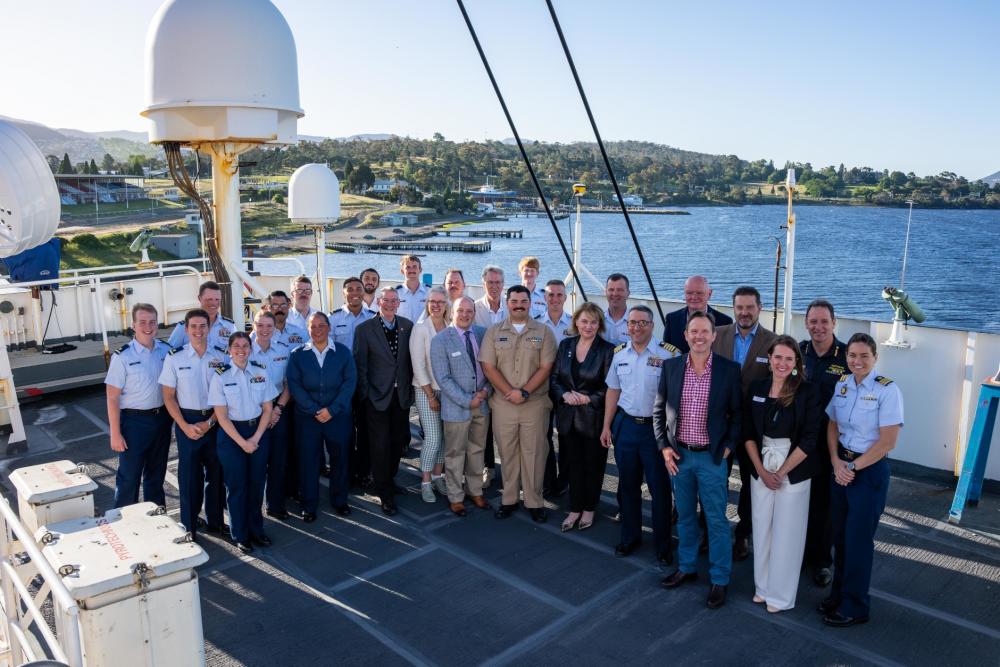United States’ only operational heavy icebreaker departs Australia, bound for Antarctica
U.S. Coast Guard sent this bulletin at 12/23/2022 02:29 PM EST
| News Release |
Dec. 23, 2022 |
United States’ only operational heavy icebreaker departs Australia, bound for Antarctica
 |
 |
 |
 |
Editors' Note: Click on images to download high resolution version.
HOBART, Australia — The U.S. Coast Guard Cutter Polar Star (WAGB 10) crew departed Hobart, December 21, 2022, to begin their journey across the Southern Ocean en route to Antarctica in support of Operation Deep Freeze 2023.
The Polar Star’s Hobart port call was part of the crew’s annual deployment to Antarctica where they will support Operation Deep Freeze, a joint military service mission to resupply the United States Antarctic stations of the National Science Foundation, the lead agency for the United States Antarctic Program (USAP).
The Polar Star departed its Seattle homeport Nov. 16 and has already traveled approximately 7,675 miles with stops in Honolulu, Sydney, and Hobart.
The Polar Star’s four-day port call in Hobart was their final stop before reaching Antarctica. While in Hobart, the crew hosted a reception aboard the Polar Star for guests from the Australian Antarctic Division, Australian Border Force, Tasmanian government representatives, and local industry partners.
“The reception was a good way for us to thank our Tasmanian hosts for their part in Polar Star’s mission success,” said Capt. Keith Ropella, Polar Star’s commanding officer. “We are proud to work alongside all the other Antarctic programs and the continued success of Operation Deep Freeze is dependent on these invaluable international partnerships.”
This year marks Polar Star’s 26th voyage to Antarctica. Every year, a joint and total force team work together to complete a successful Operation Deep Freeze season. Military members from the U.S. Air Force, Army, Coast Guard, and Navy work together through Joint Task Force-Support Forces Antarctica to continue the tradition of providing U.S. military support. Operation Deep Freeze works closely with other Antarctic programs to include those of Australia, New Zealand, and Italy, as well as those Nations’ respective defense forces.
Leading up to and during the transit, the crew received training and prepared themselves to support this vital mission despite the austere environment. Operation Deep Freeze is one of the more challenging U.S. military peacetime missions due to the harsh environment in which it is conducted. Antarctica is the coldest, windiest, most inhospitable continent on the globe, and each trip requires careful planning and coordination.
“Our crew receives countless hours of unique and specialized icebreaking training to ensure they are properly equipped to carry out this vital mission,” said Lt. Cmdr. Benjamin Litts, Polar Star’s operations officer. “The success of U.S. missions in the Polar Regions remains a top priority for the Coast Guard.”
The Polar Star provides heavy icebreaking capabilities to facilitate sealift, seaport access, bulk fuel supply, and port cargo handling for three U.S. research stations in Antarctica with McMurdo Station being the largest.
Polar Star’s icebreaking capabilities enable the safe delivery of critical supplies to sustain USAP’s year-round operations and support international partnership in the harsh Antarctic environment. It’s vitally important that the U.S. maintains a maritime domain presence in Antarctica to protect uninhibited international access to the region.
When the Polar Star deploys in support of Operation Deep Freeze, they routinely spend Thanksgiving and Christmas holidays away from home. During the cutter’s first stop in Honolulu, the crew celebrated Thanksgiving while moored alongside the U.S. Navy fleet at Joint Base Pearl Harbor-Hickam in Honolulu.
During the transit across the Pacific, the crew sailed through the position 0 degrees latitude and 180 degrees longitude marking the intersection of the equator and international date line. Crossing this exact position is a unique and rare opportunity among Coast Guard crews, said Ropella.
On Dec. 14, the Polar Star moored at a Royal Australian Navy fuel pier in Chowder Bay close to the center of Sydney during a logistics stop for fuel and supplies.
The Polar Star is the United States’ only asset capable of providing access to both Polar Regions. It is a 399-foot heavy polar icebreaker commissioned in 1976, weighing 13,500 tons, 84-feet wide, with a 34-foot draft. The six diesel and three gas turbine engines produce up to 75,000 horsepower.
-USCG-

